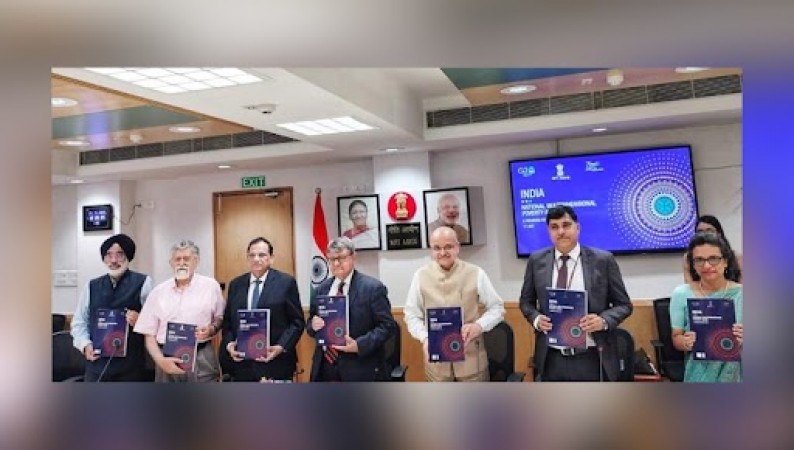
NEW DELHI: In a groundbreaking revelation, the NITI Aayog's report titled "National Multidimensional Poverty Index: A Progress Review 2023" has disclosed that an astounding 135 million individuals successfully lifted themselves out of multidimensional poverty between 2015-16 and 2019-21. The report, which was ceremoniously released today in the presence of distinguished personalities including Shri Suman Bery (Vice-Chairman of NITI Aayog), Dr. V K. Paul and Dr. Arvind Virmani (Members of NITI Aayog), and Shri B. V. R. Subrahmanyam (CEO of NITI Aayog), signifies a remarkable turning point in India's quest for prosperity.
Drawing on the latest National Family Health Survey [NFHS-5 (2019-21)], this second edition of the National Multidimensional Poverty Index (MPI) effectively portrays India's strides in combating multidimensional poverty compared to the previous surveys, NFHS-4 (2015-16) and NFHS-5 (2019-21). The methodology employed aligns seamlessly with the global standards, building upon the Baseline Report of India's National MPI launched in November 2021.
The National MPI serves as a comprehensive measure that accounts for simultaneous deprivations across three equally weighted dimensions: health, education, and standard of living. These dimensions are adequately represented by a set of 12 indicators aligned with the Sustainable Development Goals (SDGs). They include vital aspects such as nutrition, child and adolescent mortality, maternal health, educational attainment, school attendance, access to basic amenities like cooking fuel, sanitation, drinking water, electricity, housing, possession of assets, and availability of bank accounts. Encouragingly, all 12 indicators exhibit notable progress.
According to the report, India has witnessed a significant decline of 9.89 percentage points in the population experiencing multidimensional poverty, plummeting from 24.85% in 2015-16 to 14.96% in 2019-2021. The rural areas have experienced the most rapid reduction in poverty rates, from 32.59% to 19.28%. Concurrently, the urban areas have witnessed a decline from 8.65% to 5.27%. The state of Uttar Pradesh has notably registered the largest decline, with a staggering 34.3 million people escaping multidimensional poverty. Highlighting the progress made at the subnational level, the report presents multidimensional poverty estimates for all 36 states and union territories, as well as 707 administrative districts. It identifies Uttar Pradesh, Bihar, Madhya Pradesh, Odisha, and Rajasthan as the states with the swiftest reduction in the proportion of multidimensionally poor.
Over the course of 2015-16 and 2019-21, the MPI value has nearly halved, dwindling from 0.117 to 0.066, while the intensity of poverty has decreased from 47% to 44%. This momentous achievement firmly positions India on track to surpass SDG Target 1.2 of halving multidimensional poverty well ahead of the stipulated 2030 deadline. This remarkable feat underscores the government's unwavering commitment to sustainable and equitable development and its resolute determination to eradicate poverty by 2030, in alignment with the SDGs.
The government's unwavering focus on improving access to vital services such as sanitation, nutrition, cooking fuel, financial inclusion, drinking water, and electricity has yielded significant advancements in these areas. All 12 parameters of the MPI have exhibited marked improvements. Flagship programs like the Poshan Abhiyan and Anaemia Mukt Bharat have made substantial contributions towards alleviating health-related deprivations. Furthermore, initiatives such as the Swachh Bharat Mission (SBM) and the Jal Jeevan Mission (JJM) have been instrumental in enhancing sanitation facilities nationwide.
The impact of these efforts is evident in the substantial 21.8 percentage points improvement in sanitation-related deprivations. The provision of subsidized cooking fuel through the Pradhan Mantri Ujjwala Yojana (PMUY) has undeniably transformed lives, leading to a remarkable 14.6 percentage points enhancement in cooking fuel accessibility. Initiatives like Saubhagya, Pradhan Mantri Awas Yojana (PMAY), Pradhan Mantri Jan Dhan Yojana (PMJDY), and Samagra Shiksha have also played pivotal roles in significantly reducing multidimensional poverty across the country.
The government's steadfast commitment to improving citizens' lives and creating a brighter future for all is clearly demonstrated by the outstanding progress achieved in areas such as electricity accessibility, bank account ownership, and access to clean drinking water. The consistent implementation of a diverse array of programs and initiatives with strong interlinkages has contributed immensely to reducing deprivations across multiple indicators.